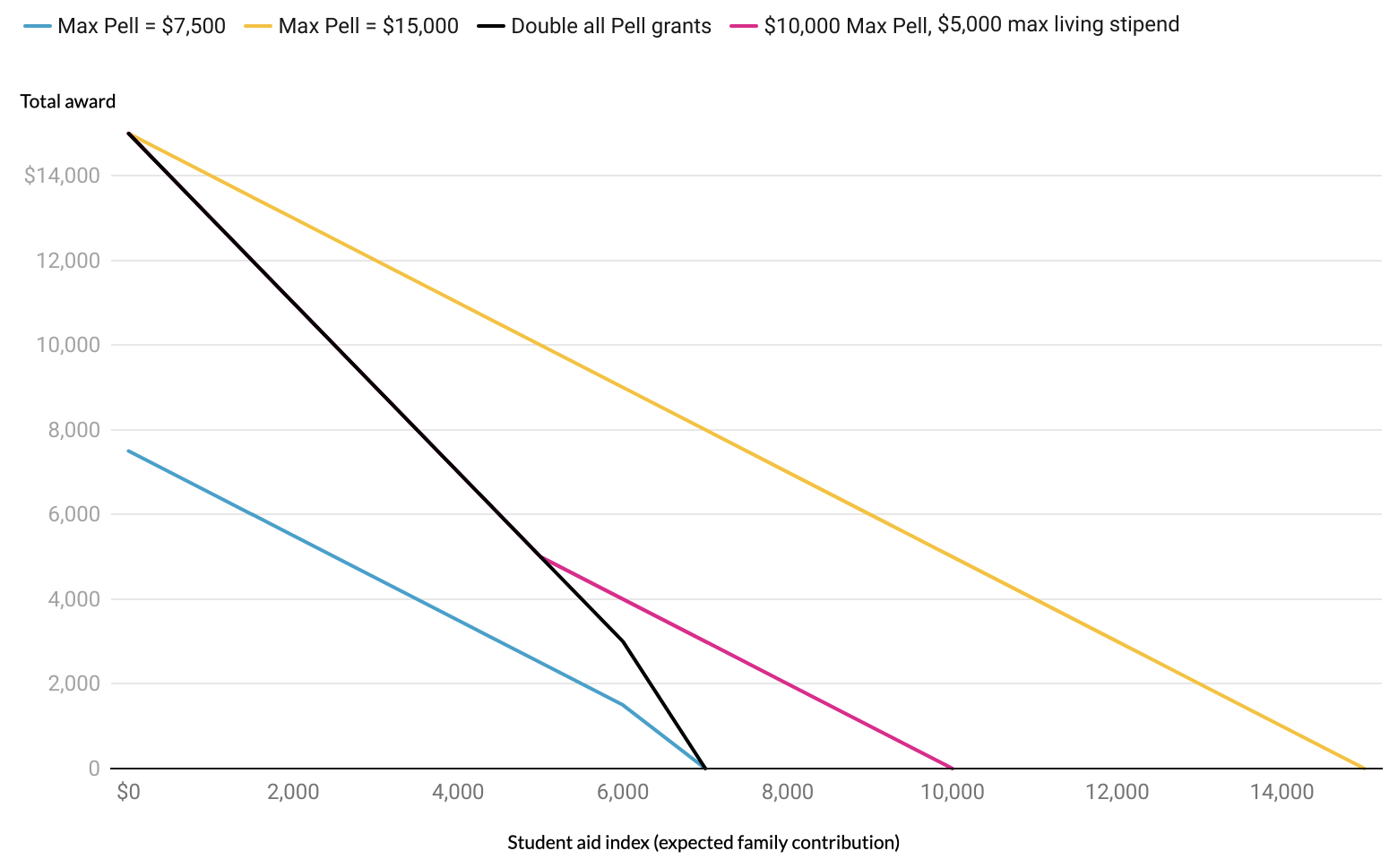
Advocates for increasing federal grant aid for low- and moderate-income students frequently focus on doubling the Pell grant. #DoublePell, a coalition of organizations expressing concern for students who need more aid for college, states that “doubling the maximum Pell Grant will help more students earn a degree, get a good-paying job, and ensure them greater economic mobility.” (In 2024–25, doubling the Pell maximum would raise it from $7,395 to $14,790.)
It sounds like “double Pell” means the aid every student receives under the program would double. But a simple doubling of the maximum Pell grant would mean most recipients would see the same dollar award increase, disproportionately helping the highest-income Pell recipients. A student now receiving a $1,000 grant would see that amount increase to about $8,500. If the goal is to maximize federal aid to low-income students, there are better ways to structure increased federal grant aid.
Doubling the maximum Pell would disproportionately benefit higher-income Pell recipients
Many Pell recipients receive less than the maximum award, with Pell grants of $2,000 or $5,000 or any other amount below the maximum. Pell amounts are determined through a Student Aid Index (SAI)—formerly called expected family contributions—which uses a formula to assess how much a household can pay. If a full-time student has an SAI of $0, they receive the full Pell amount. If a student has an SAI greater than $0, they receive the difference between the maximum and their SAI as long as that amount is above the minimum $750 grant.
The higher the student’s income and SAI, the smaller their current award and the greater proportional increase they would see if the maximum award doubled. For students who receive smaller Pell awards, doubling the maximum Pell grant without otherwise changing the Pell formula would lead to the same dollar increase—about $7,395.
In addition, raising the maximum Pell amount would mean many more students would qualify for the awards, as the SAI threshold would approximately double as well. As such, many students who currently do not receive Pell grants because their household incomes are too high—but still too low to comfortably cover all college expenses—would begin receiving awards.
Ultimately, doubling the maximum Pell would lead to more students receiving federal grant aid, but it would not target the extra funds to the students experiencing the most severe financial hardship.
Other options to supplement Pell awards could better target federal aid
An alternative approach could provide a similar increase in aid for the lowest-income students but smaller dollar increases for higher-income Pell recipients.
Doubling all Pell awards would give the largest funding increases in dollar terms to the lowest- income students, rather than distributing them equally across Pell recipients, as a simple doubling of the Pell maximum would. Also, doubling Pell awards for all recipients would double the overall cost of the program—in contrast to doubling the maximum award, which would be significantly more expensive.
But there is no reason this additional funding must be tied exactly to the current Pell grant. Instead of doubling all existing awards, policymakers could create a new, supplementary award that has a lower maximum and declines more slowly or more rapidly with SAI than the existing grant, extending the stipend to a higher or lower income limit than that reached by Pell.
Consider that even for students whose grant aid covers tuition and fees, other expenses such as housing, food, books, supplies, and transportation frequently create barriers to success. Although students with the lowest incomes are most likely to have difficulty covering basic needs, all Pell recipients could use some extra money.
One option would be to increase the maximum Pell grant to $10,000 and add a living stipend with a $5,000 maximum—enough to cover books and supplies and a meaningful allowance for food. Students who qualified for the maximum award would receive a total of $15,000—approximately the amount doubling the Pell maximum would give them.
Instead of Doubling the Maximum Pell Grant, Other Policy Changes Could Direct a Higher Share of New Federal Aid to the Students with the Lowest Incomes

Source: Author’s calculations based on the Pell Grant formula.
With this option, a higher share of the new dollars would go to the lowest-income students who quality for the maximum award, and more middle-income students would be brought into the system with the maximum Pell increase to $10,000. Compared with doubling the maximum award, a smaller share of aid would go to students with higher SAIs, and the additional cost to taxpayers would be lower. Policymakers could extend the living stipend further up the SAI scale than either the current Pell grant or doubling current awards, but not as far as doubling the maximum grant.
Increasing federal aid to students with low and moderate incomes is a vital step for improving educational opportunity and attainment. Ensuring students can cover basic expenses while they’re in college in addition to paying their tuition could support completion for many students. But how policymakers structure the increased aid is critical to ensuring the students with the greatest need benefit most and taxpayer dollars are used efficiently.
Let’s build a future where everyone, everywhere has the opportunity and power to thrive
Urban is more determined than ever to partner with changemakers to unlock opportunities that give people across the country a fair shot at reaching their fullest potential. Invest in Urban to power this type of work.